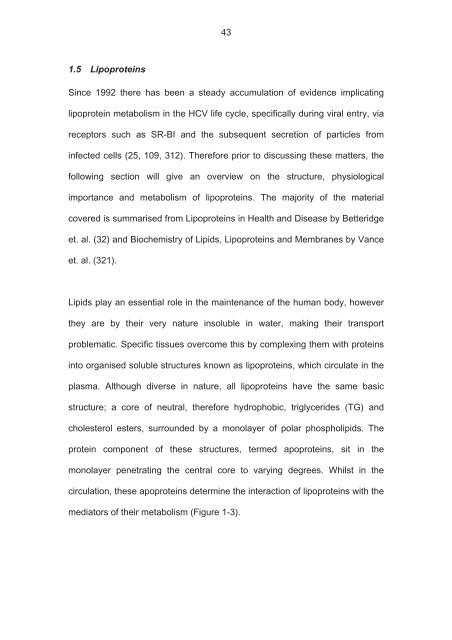The role of scavenger receptor BI in hepatitis - eTheses Repository ...
The role of scavenger receptor BI in hepatitis - eTheses Repository ...
The role of scavenger receptor BI in hepatitis - eTheses Repository ...
Create successful ePaper yourself
Turn your PDF publications into a flip-book with our unique Google optimized e-Paper software.
1.5 Lipoprote<strong>in</strong>s<br />
43<br />
S<strong>in</strong>ce 1992 there has been a steady accumulation <strong>of</strong> evidence implicat<strong>in</strong>g<br />
lipoprote<strong>in</strong> metabolism <strong>in</strong> the HCV life cycle, specifically dur<strong>in</strong>g viral entry, via<br />
<strong>receptor</strong>s such as SR-<strong>BI</strong> and the subsequent secretion <strong>of</strong> particles from<br />
<strong>in</strong>fected cells (25, 109, 312). <strong>The</strong>refore prior to discuss<strong>in</strong>g these matters, the<br />
follow<strong>in</strong>g section will give an overview on the structure, physiological<br />
importance and metabolism <strong>of</strong> lipoprote<strong>in</strong>s. <strong>The</strong> majority <strong>of</strong> the material<br />
covered is summarised from Lipoprote<strong>in</strong>s <strong>in</strong> Health and Disease by Betteridge<br />
et. al. (32) and Biochemistry <strong>of</strong> Lipids, Lipoprote<strong>in</strong>s and Membranes by Vance<br />
et. al. (321).<br />
Lipids play an essential <strong>role</strong> <strong>in</strong> the ma<strong>in</strong>tenance <strong>of</strong> the human body, however<br />
they are by their very nature <strong>in</strong>soluble <strong>in</strong> water, mak<strong>in</strong>g their transport<br />
problematic. Specific tissues overcome this by complex<strong>in</strong>g them with prote<strong>in</strong>s<br />
<strong>in</strong>to organised soluble structures known as lipoprote<strong>in</strong>s, which circulate <strong>in</strong> the<br />
plasma. Although diverse <strong>in</strong> nature, all lipoprote<strong>in</strong>s have the same basic<br />
structure; a core <strong>of</strong> neutral, therefore hydrophobic, triglycerides (TG) and<br />
cholesterol esters, surrounded by a monolayer <strong>of</strong> polar phospholipids. <strong>The</strong><br />
prote<strong>in</strong> component <strong>of</strong> these structures, termed apoprote<strong>in</strong>s, sit <strong>in</strong> the<br />
monolayer penetrat<strong>in</strong>g the central core to vary<strong>in</strong>g degrees. Whilst <strong>in</strong> the<br />
circulation, these apoprote<strong>in</strong>s determ<strong>in</strong>e the <strong>in</strong>teraction <strong>of</strong> lipoprote<strong>in</strong>s with the<br />
mediators <strong>of</strong> their metabolism (Figure 1-3).

















